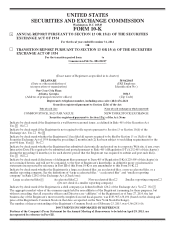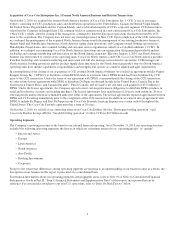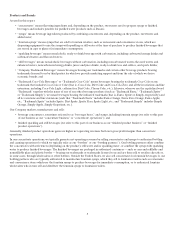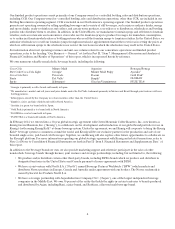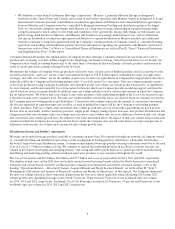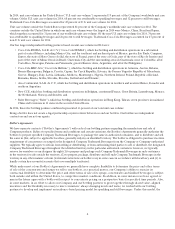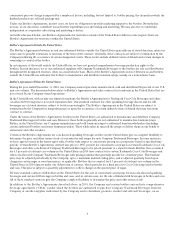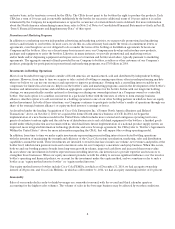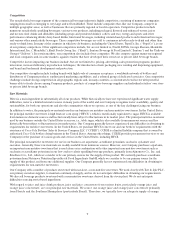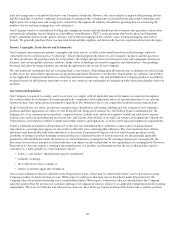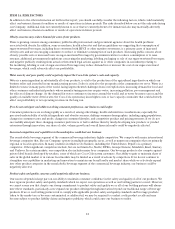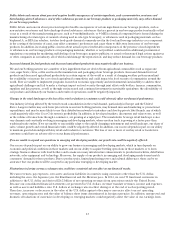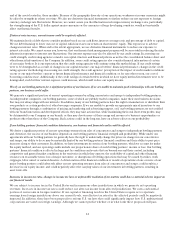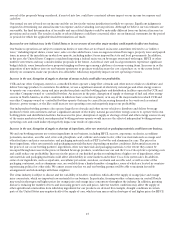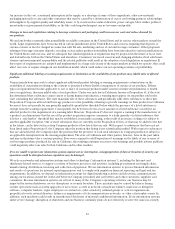Coca Cola 2014 Annual Report Download - page 8
Download and view the complete annual report
Please find page 8 of the 2014 Coca Cola annual report below. You can navigate through the pages in the report by either clicking on the pages listed below, or by using the keyword search tool below to find specific information within the annual report.6
In 2014, unit case volume in the United States (“U.S. unit case volume”) represented 19 percent of the Company’s worldwide unit case
volume. Of the U.S. unit case volume for 2014, 68 percent was attributable to sparkling beverages and 32 percent to still beverages.
Trademark Coca-Cola Beverages accounted for 45 percent of U.S. unit case volume for 2014.
Unit case volume outside the United States represented 81 percent of the Company’s worldwide unit case volume for 2014. The
countries outside the United States in which our unit case volumes were the largest in 2014 were Mexico, China, Brazil and Japan,
which together accounted for 31 percent of our worldwide unit case volume. Of the non-U.S. unit case volume for 2014, 74 percent
was attributable to sparkling beverages and 26 percent to still beverages. Trademark Coca-Cola Beverages accounted for 47 percent of
non-U.S. unit case volume for 2014.
Our five largest independent bottling partners based on unit case volume in 2014 were:
• Coca-Cola FEMSA, S.A.B. de C.V. (“Coca-Cola FEMSA”), which has bottling and distribution operations in a substantial
part of central Mexico, including Mexico City, and the southeast and northeast parts of Mexico; greater São Paulo, Campinas,
Santos, the state of Mato Grosso do Sul, the state of Paraná, part of the state of Goiás, part of the state of Rio de Janeiro and
part of the state of Minas Gerais in Brazil; Guatemala City and the surrounding areas in Guatemala; most of Colombia; all of
Costa Rica, Nicaragua, Panama and Venezuela; greater Buenos Aires, Argentina; and all of the Philippines;
• Coca-Cola HBC AG (“Coca-Cola Hellenic”), which has bottling and distribution operations in Armenia, Austria, Belarus,
Bosnia-Herzegovina, Bulgaria, Croatia, Cyprus, the Czech Republic, Estonia, the Former Yugoslav Republic of Macedonia,
Greece, Hungary, Italy, Latvia, Lithuania, Moldova, Montenegro, Nigeria, Northern Ireland, Poland, Republic of Ireland,
Romania, Russia, Serbia, Slovakia, Slovenia, Switzerland and Ukraine;
• Arca Continental, S.A.B. de C.V., which has bottling and distribution operations in northern and western Mexico, Ecuador and
northern Argentina;
• New CCE, which has bottling and distribution operations in Belgium, continental France, Great Britain, Luxembourg, Monaco,
the Netherlands, Norway and Sweden; and
• Swire Beverages (“Swire”), which has bottling and distribution operations in Hong Kong, Taiwan, seven provinces in mainland
China and territories in 11 states in the western United States.
In 2014, these five bottling partners combined represented 33 percent of our total unit case volume.
Being a bottler does not create a legal partnership or joint venture between us and our bottlers. Our bottlers are independent
contractors and are not our agents.
Bottler’s Agreements
We have separate contracts (“Bottler’s Agreements”) with each of our bottling partners regarding the manufacture and sale of
Company products. Subject to specified terms and conditions and certain variations, the Bottler’s Agreements generally authorize the
bottlers to prepare specified Company Trademark Beverages, to package the same in authorized containers, and to distribute and sell
the same in (but, subject to applicable local law, generally only in) an identified territory. The bottler is obligated to purchase its entire
requirement of concentrates or syrups for the designated Company Trademark Beverages from the Company or Company-authorized
suppliers. We typically agree to refrain from selling or distributing, or from authorizing third parties to sell or distribute, the designated
Company Trademark Beverages throughout the identified territory in the particular authorized containers; however, we typically
reserve for ourselves or our designee the right (1) to prepare and package such Company Trademark Beverages in such containers
in the territory for sale outside the territory, (2) to prepare, package, distribute and sell such Company Trademark Beverages in the
territory in any other manner or form (territorial restrictions on bottlers vary in some cases in accordance with local law), and (3) to
handle certain key accounts (accounts that cover multiple territories).
While under most of our Bottler’s Agreements we generally have complete flexibility to determine the price and other terms
of sale of the concentrates and syrups we sell to our bottlers, as a practical matter, our Company’s ability to exercise its
contractual flexibility to determine the price and other terms of sale of its syrups, concentrates and finished beverages is subject,
both outside and within the United States, to competitive market conditions. In addition, in some instances we have agreed or
may in the future agree with a bottler with respect to concentrate pricing on a prospective basis for specified time periods. Also,
in some markets, in an effort to allow our Company and our bottling partners to grow together through shared value, aligned
incentives and the flexibility necessary to meet consumers’ always changing needs and tastes, we worked with our bottling
partners to develop and implement an incidence-based pricing model for sparkling and still beverages. Under this model, the

